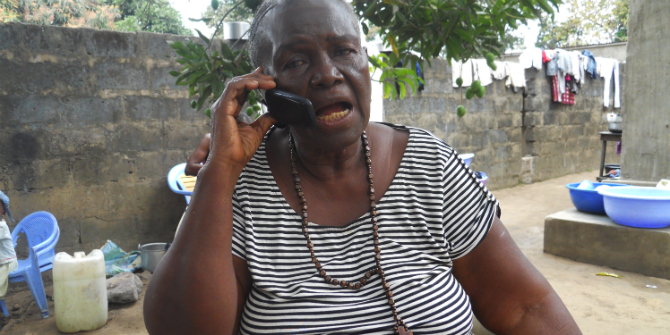 In the first of four posts presenting findings from the Makerspaces in the early years (MakEY) final report, Sonia Livingstone, Alicia Blum-Ross, and Paige Mustain outline the key roles that parents adopt when accompanying their children to makerspaces. Sonia Livingstone is Professor of Social Psychology at LSE’s Department of Media and Communications and is the lead investigator of the Parenting for a Digital Future research project. Alicia Blum-Ross is a visiting professor in the Department of Media and Communications. Paige Mustain is a research assistant for the Parenting for a Digital Future project and Julian Sefton-Green’s Preparing for Creative Labour.
In the first of four posts presenting findings from the Makerspaces in the early years (MakEY) final report, Sonia Livingstone, Alicia Blum-Ross, and Paige Mustain outline the key roles that parents adopt when accompanying their children to makerspaces. Sonia Livingstone is Professor of Social Psychology at LSE’s Department of Media and Communications and is the lead investigator of the Parenting for a Digital Future research project. Alicia Blum-Ross is a visiting professor in the Department of Media and Communications. Paige Mustain is a research assistant for the Parenting for a Digital Future project and Julian Sefton-Green’s Preparing for Creative Labour.
Although families of all stripes have long taken part in ‘making and tinkering’ activities – from cooking to fixing bikes to sewing and beyond – bringing these types of activities (often linking them to newly accessible digital technologies) into formal and non-formal learning settings has been a major trend in formal and non-formal education in recent years.
As we discussed in a previous post, as part of our interest in parenting, we took part in the international Makerspaces in the Early Years project, led by Jackie Marsh at University of Sheffield. From January 2017 – September 2018 we made multiple visits to three museum makerspaces in the San Francisco Bay Area, seeking to understand how parents support children to gain the building blocks towards digital literacy by engaging in hands-on making and tinkering projects.
Parenting roles in makerspaces
These parents, many of whom were highly digitally skilled (the SF Bay Area encompasses Silicon Valley, thus many families work within or adjacent to the technology industry), occupied a variety of different supportive roles when they accompanied their young children. We sought to map out these different ‘roles’ played by parents, in part inspired by studies by Barron et al. (2009) and Brough et al (in a forthcoming volume on Connected Learning) who determined that parents play distinct roles as ‘learning’ partners in helping children develop technological skills.
At the same time, we were also cognisant of a different, parallel but influential set of discourses. There are several popular culture representations of parenting categories like “free-range” or “helicopter” parents, which simultaneously critique parents for being too hands-off or two hands-on. Or indeed, the new folk devil, “distracted parents,” who are characterised by allowing their own screen time to interfere with attention meant to be spent on their child. As in our forthcoming book, Parenting for a Digital Future, although we recognised many of these stereotypes in parents’ behaviour we also saw the multitude of different ways in which they moved between one role and the next – indeed especially so if they had children of multiple ages with them. These roles included:
- Babysitting. These parent sat at the back – there for the basic physical safety of their child but not following or engaging in the making activities. While one might feel judgemental of these parents from afar, when we observed (or parents volunteered) what they were doing we saw parents nodding off from exhaustion, breastfeeding younger children, checking time sensitive work emails (having come to the museum during their own work hours) and beyond.
- Supervising when parents stood back and carefully observed – not involved in the activity but not turning their attention elsewhere either (e.g. to their phones). Where at first it seemed that some parents were ‘babysitting’ it was actually a hands-off yet highly engaged form of encouragement. For some, this was part of a parenting philosophy in which the child should lead the activity for example one mother of a six year old said:
“If I’m with him, he will want me to help him. So I often try and just leave him alone. I want him to feel challenged when his mind doesn’t know how to do something, or when he thinks he might not be able to do something. If I’m not there, and he is forced to figure it out, then that’s where the magic happens, and that’s where growing happens.”
- Cheerleading was perhaps the most common role for parents – these parents praised their child’s accomplishments by taking photos or videos and cheering them on, often loudly, sometimes at the cost of the collaborative or process-led learning ethos attempted by the educators.
- Collaborating is a more hands-on approach. We watched a lot of parents in the makerspaces physically assisting in the creation, or collaborating with their children on what the design would look like once completed. In practice, we noted that some collaborative parents were tempted to ‘take over’ for their children. This is a tendency that facilitators tried to shift into ‘parallel play.’
- Parallel play, a term from early childhood education which denotes when children play with separate materials but side-by-side, was also a common practice, in some cases facilitators explained that they would purposefully give parents their own set of materials in order to facilitate this, or encourage a sense of competition between parents and children.
As discussed, parents did not stick with these categories prescriptively but rather often moved between and amongst them.
Parents as connectors
Rather than jumping to judge some of the parents – especially those being too hands-off or those ‘taking over’ – we have instead tried to understand how parents may be tailoring their actions (or inactions) according to their own understandings, skills and values, and needs of their children.
One overlooked contribution of the parents is the work they did in connecting their child’s learning experiences across sites, helping them make sense of the makerspace activities in relation to other parts of their lives. Parents’ knowledge of their children, knowing when to push, and what might motivate, were also complemented by their physical intimacy and ability to help children when needed. However, sometimes that intimate knowledge could also get in the way of parents’ ability to see when they needed to step back.
Educators, who have greater knowledge of the mechanics of making itself, can thus work in tandem with parents’ more intimate knowledge. In all we saw that parents often made reasoned choices as to which role they acted in over another. Their own experiences with their children informed these choices. Instead of seeing parents as merely too engaged or disengaged, we suggest that a typology of parent actions (rather than of individual parents because some moved across these categories) is helpful in providing reflections that can be shared with the facilitators to help develop new initiatives and support for parents in the future.
The full report is available here.
This post gives the views of the authors and does not represent the position of the LSE Parenting for a Digital Future blog, nor of the London School of Economics and Political Science.








